Beyond the Blue: Johnston Atoll Mapping
(EX2405, EX2406)
Learning at Sea: Q&A with Ocean Mapping Explorers-in-Training
As part of its mission to train the next generation of ocean explorers, NOAA Ocean Exploration hosts students each year through the Explorer-in-Training Program. As the internship program coordinator for our office, I had the privilege of sailing aboard NOAA Ship Okeanos Explorer during the second Beyond the Blue: Johnston Atoll Mapping expedition. Not only was this my first time going to sea with NOAA Ocean Exploration and a great opportunity to learn about our expedition operations firsthand, I also got to spend time with three explorers-in-training: Abby Norstad, Gina Knox, and Nathanael Mathis. Here, I ask them about their experience in the program, life at sea as an ocean mapping intern, and their favorite deep-sea creature or feature!
Video courtesy of NOAA Ocean Exploration, Beyond the Blue: Johnston Atoll Mapping. Download largest version (mp4, 147 MB)
Q:
Tell me about your background or interests, and what motivated you to apply for the Explorer-in-Training Program?
A:
Abby: I recently graduated with my B.S. in geology from the University of Wisconsin — Eau Claire. A professor from college encouraged me to apply so that I could get more research experience before applying to graduate school, and the program seemed like a great opportunity to gain new experiences in oceanography.
Gina: I am a senior in geography at Old Dominion University with an Army and geospatial analysis background. Everything I had done in my career prior had been geospatial analysis for air, space, and land, but never anything with the ocean. Wanting to diversify my geography portfolio, the ocean was the last system I hadn’t explored.
Nathanael: I’m a senior at Stockton University and currently doing research related to astrobiology and icy moons. I have academic and professional experience working in labs, but I wanted to get more experience in field research, learn about oceanography and ocean exploration, and gain more interdisciplinary skills for my career.
Photo of Nathanael Mathis. Person smiling on a ship's deck with ocean and sky in the background.
Photo of Gina Knox. Person smiling on the ship with the ocean and sky in the background.
Photo of Abby Norstad. Person in denim attire smiling on a ship's deck with an ocean and cloudy sky backdrop.
Q:
What are your daily responsibilities as an explorer-in-training?
A:
Gina: As explorers-in-training, we help monitor and process the multibeam sonar data as it comes in to make sure that the data we’re sharing that we get from the sonars accurately represents the seafloor. We also launch expendable bathythermographs (XBTs) to measure temperature through the water and calculate sound speed profiles so we can correct the sonar readings for refraction in the water column.
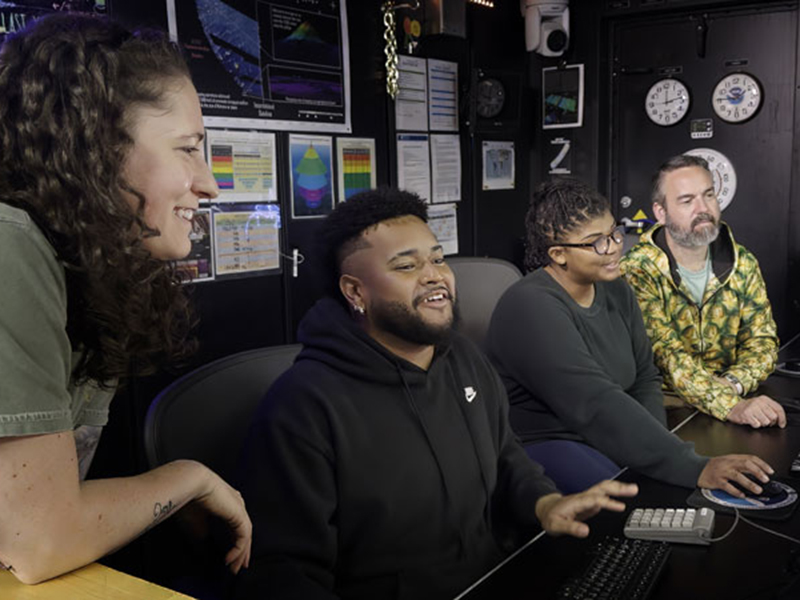
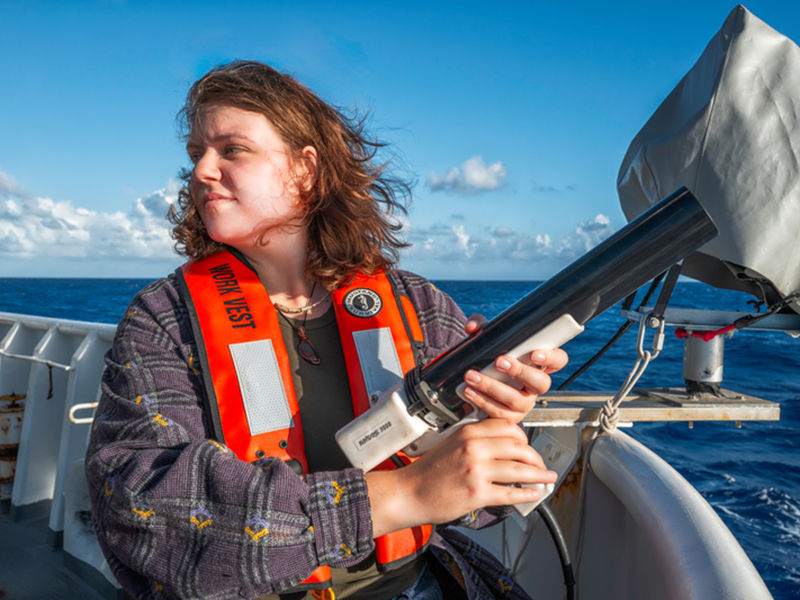
Q:
What is the coolest thing you’ve learned or seen during the expedition?
A:
Abby: I expected to see seamounts, but it was neat to see just how many volcanic features were on the seafloor! We also saw an underwater river channel, and the valley created by the outflow had 20-meter [65.6 feet] high sand ripples, which was really cool to see!

Gina: I have learned a lot more than expected about science communications and outreach. I have always loved the prospect of sharing science with different audiences and got to participate in several live interactions while on Okeanos Explorer.
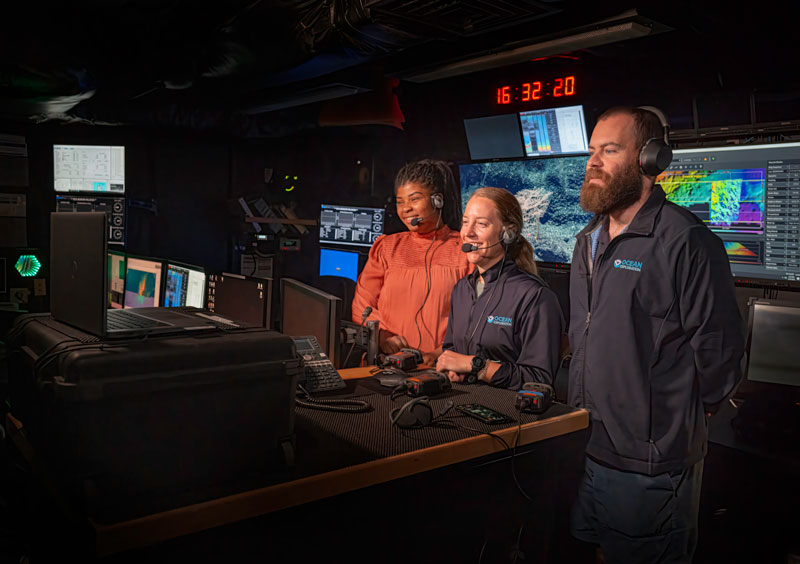
Nathanael: The bioluminescence! We were able to see it almost every night as animals crashed against the hull of the ship.
Q:
What is it like living on NOAA Ship Okeanos Explorer?
A:
Abby: I like the different fun nights that they have to bring people on the ship together. My personal favorite is Sundae Sunday, where we have ice cream every Sunday night.
Gina: The ship is like a little floating village. Every person on board has an important role that keeps the operation going, and they become a part of your daily routine as well.
Nathanael: It’s like living on a rollercoaster that never stops. It’s constantly moving, throwing you side to side, but at least you’re having fun!
Q:
What has been your favorite part of your internship experience?
A:
Abby: My favorite part has been learning all there is to do on a research vessel and seeing how sonar data is collected firsthand. There is truly nothing I can compare this experience to because of how unique it is.
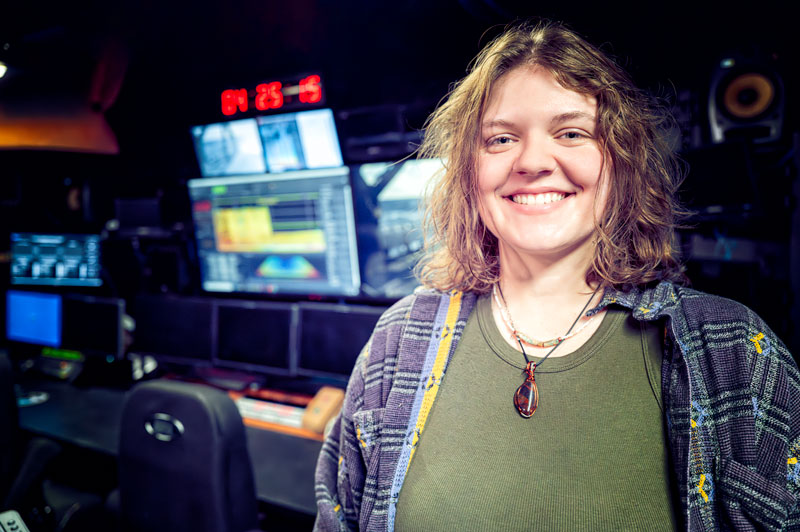
Gina: I got to tour the bridge and ask the NOAA Corps officers about their day-to-day operations. It was cool to learn more about the ship and all the different people it takes to keep everything running smoothly.
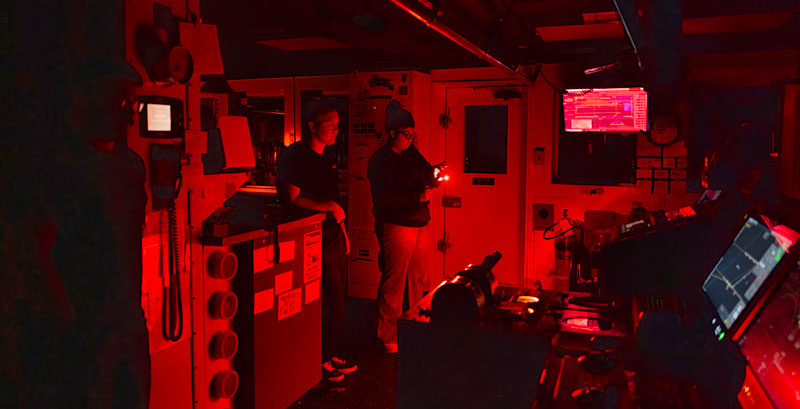
Nathanael: As an avid lover of the stars and a city boy at heart, it’s been amazing being able to see so many stars in the middle of the ocean and wake up every day feeling like a true explorer.
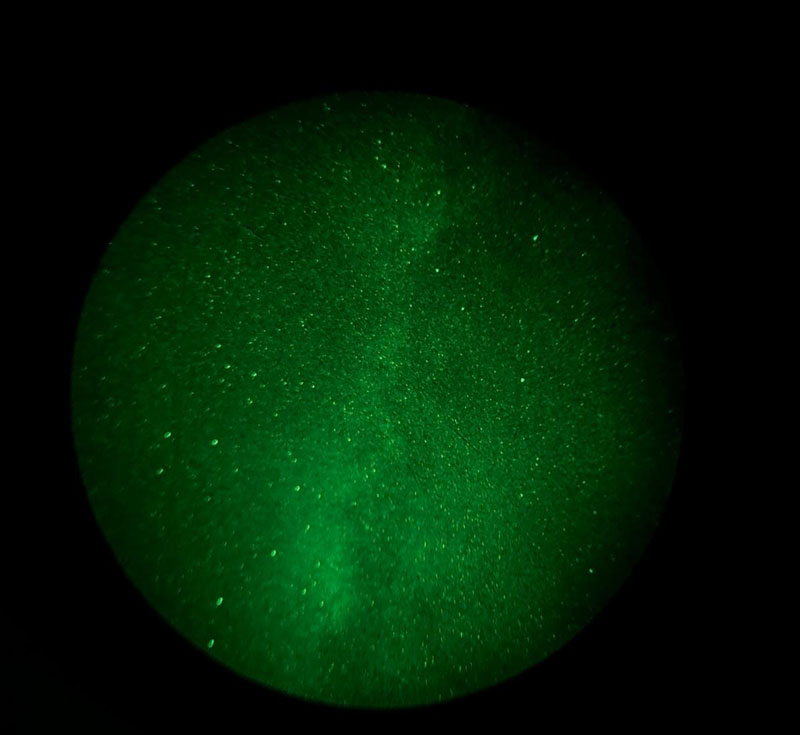
Q:
What has been the most challenging part of your experience and how have you overcome it?
A:
Abby: It was hard getting used to being isolated from your family and friends. Working eight-hour shifts plus the time zone difference makes it difficult to stay in touch. There’s not much privacy on the ship, and you are around people most of the time. As an introvert, finding the energy to also stay connected with people back home was difficult. I just tried my best to communicate this with my family and talked with them when I had the energy.
Gina: I love being outdoors, so being confined to the ship was challenging. I overcame this by changing where I’d spend time each day. I would have lunch in the galley one day, and the next I’d try lunch in the library or lounge. Variation to break up the routine helps a lot.
Nathanael: The most challenging part has been managing my seasickness, balancing my mental health while at sea, and adjusting to the repetitive work routine. It was more difficult than anything I’ve experienced before, but with a lot of determination and taking time to admire the ocean around me (and seasickness meds), I eventually got into the swing of everything!
Q:
In what ways has the internship impacted your future career goals?
A:
Abby: It gave me a better understanding of scientific research and has made me interested in pursuing new fields I hadn’t considered before, including oceanography and coastal erosion.
Gina: I received great advice and feedback on my grad school application and was able to submit it while on the ship. This was an unexpected plus of the program, but it was really great to get direct feedback from my mentors at sea.
Nathanael: This internship gave me more clarity and helped me map (no pun intended!) the next steps in my career. It also reiterated the interdisciplinary connections between ocean exploration and astrobiology — for example, researchers also use sonars and radars to map terrestrial analogs of Europa!
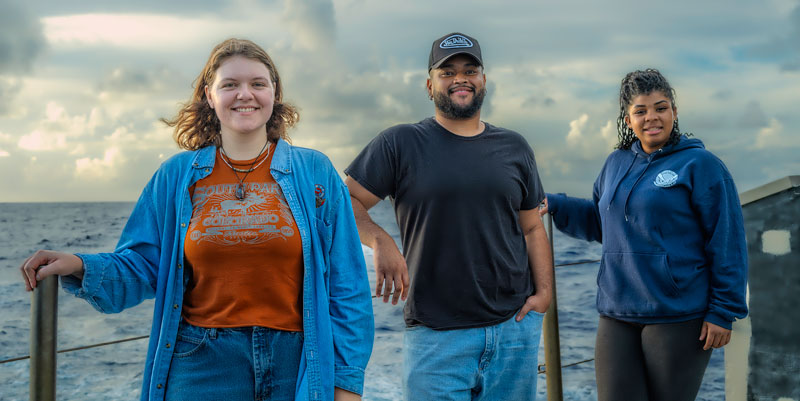
Q:
What advice would you give to future explorers-in-training that are interested in joining or preparing for an expedition?
A:
Abby: Think about how you handle social situations and challenging work environments. On the ship, you’re isolated from the outside world but live and work in close quarters with a bunch of new people. I personally loved that aspect, but it’s not for everyone.
Gina: Do your research on the realities of life as a mariner. So much of the experience has less to do with the eight hours of seafloor mapping and everything to do with how you adjust to life at sea.
Nathanael: Do what you need to do to mentally and emotionally prepare for the isolation of life at sea. I went on a lot of solo hikes and spent time in nature before leaving for the expedition and made sure I had someone at home to mentally check in with during my time here, which helped me adjust so much better!
Q:
Lastly (and most importantly), what is your favorite deep-sea creature or feature?
A:
Abby: Black smoker hydrothermal vents are really cool — they are some of the most extreme environments on the planet and have active deposition of minerals like copper and zinc.
Gina: I really love seeing colorful deep-sea coral. Specifically the red Paragorgia or "bubblegum coral" — they look like pulmonary veins under water!
Nathanael: My favorite deep-sea creature is the bloody belly comb jelly! They’re so cute, and I love their beautiful and colorful light show.
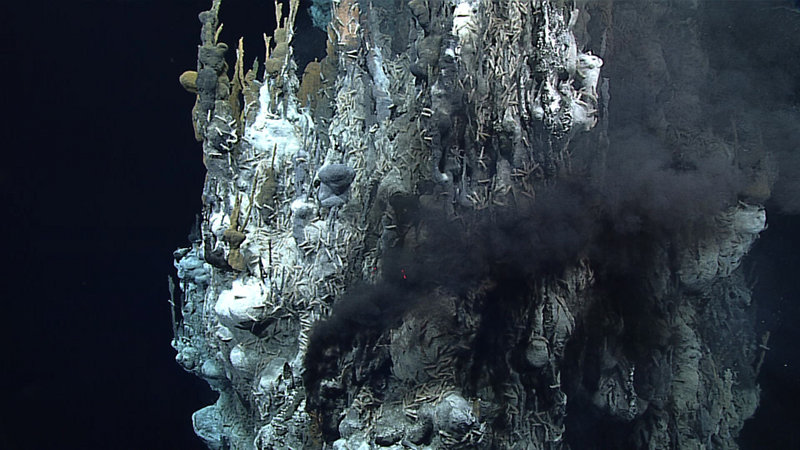
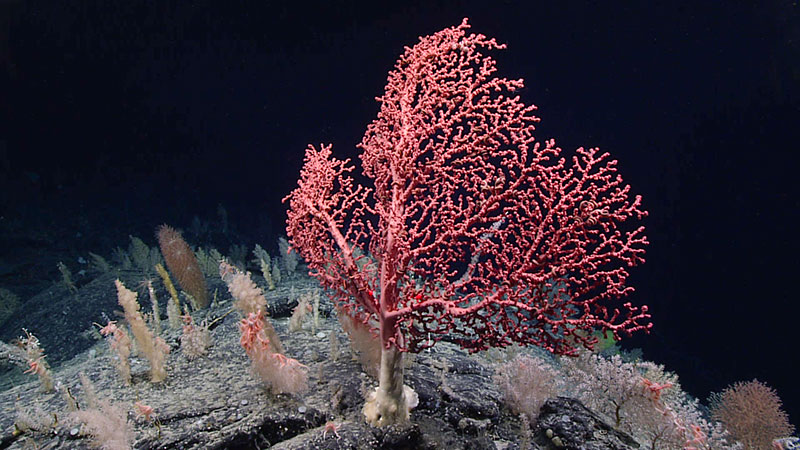
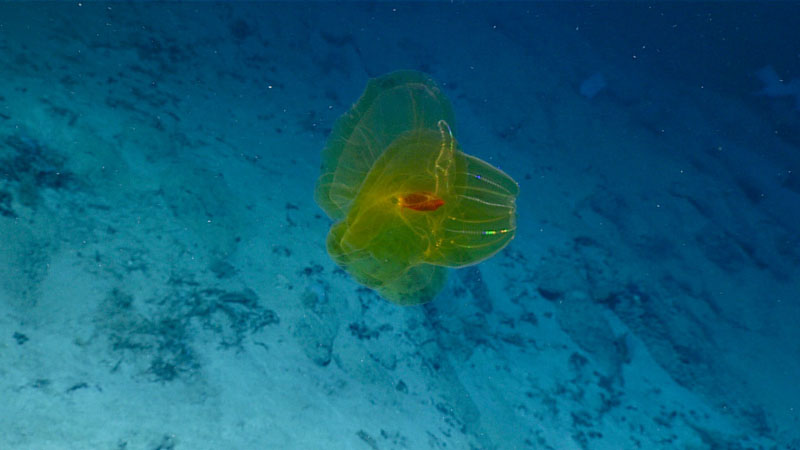
Visit our website to learn more about the Explorer-in-Training Program, meet previous student explorers, and find other career and student opportunities with NOAA Ocean Exploration.
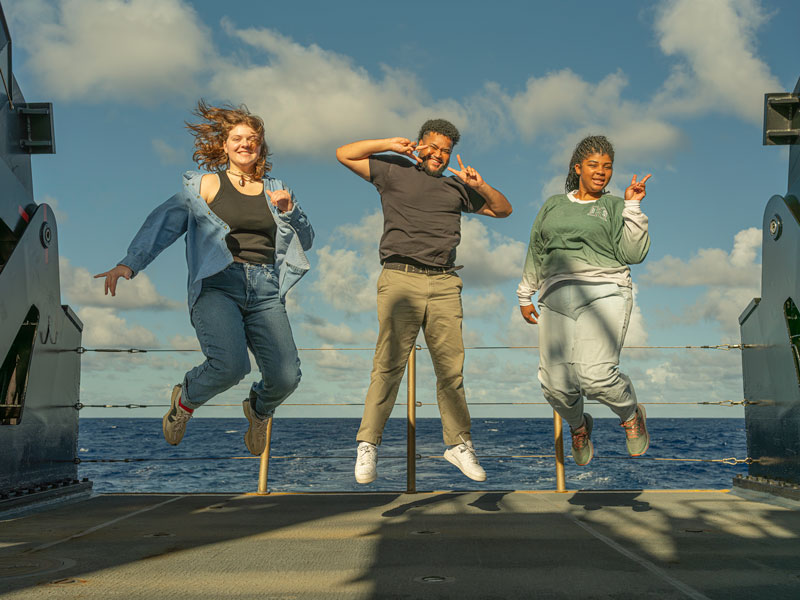
By Jesse Gwinn, Internship Program Coordinator, NOAA Ocean Exploration
Published October 22, 2024